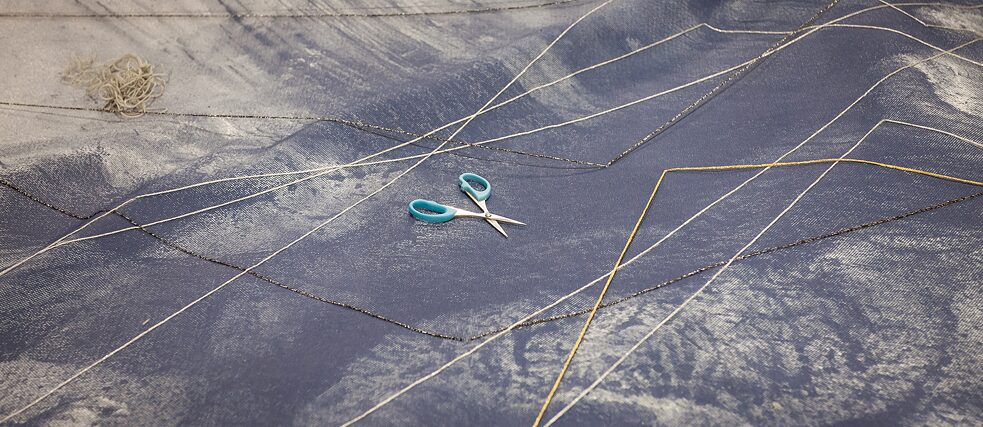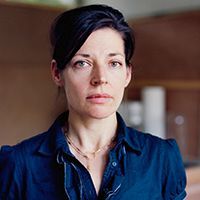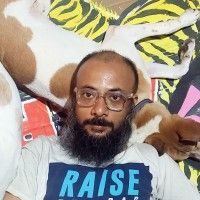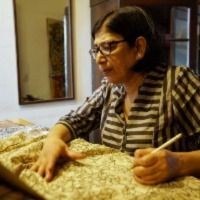Katja Davar is a German-British artist who has been commissioned to create a permanent site-specific art work at the Goethe-Institut / Max Mueller Bhavan Kolkata. Davar is interested in the impact of new and old technologies and their effects on nature and society. In her work for Kolkata, she explores the theme of technological acceleration and its impact on our planet, societies and our individual selves. Combining drawings and textile works, On Cables and Cumulus expands over three floors and visualizes aspects of technologies that are invisible and inter-woven.
Davar works around the idea that the central metaphor today for the internet is the cloud. The internet itself is inherently difficult to grasp yet it is a place of great power and energy. On the one hand, we are attracted to the romantic notion of the cloud, on the other hand, the metaphor is actually misleading as our cloud is not weightless, amorphous or invisible; it is a physical infrastructure consisting of phone lines, fiber optics and enormous warehouses filled with computers consuming excessive amounts of energy and water. Davar is interested in examining the cloud as a relatively new industry, but one that not only has a shadow, but also a footprint. Today’s clouds are both environmental, political and opaque.
In the main stairwell, a seventeen metre long textile work digitally collaged from Davar’s pencil drawings of clouds, cascades through the building. The work is titled Myth, Knowledge, Industrial Logic. Together with the artistic team of Neelanjana Ghose from West Bengal, Davar engaged in a collaborative embroidery workshop where new and imaginary embroidered routes were created on the hanging, as a form of layered storytelling in and through the clouds. Davar sees in the cloud immense horizons of interpretation, from technological computation to contemplation. The cloud is an archive of memory, information and imagination.
The installation also explores the relationships of fiber optic cables on the ocean floor which mirrors the paths of European vessels from the 17th and 18th centuries. A second work titled At Depth the Bending / Old New World is crafted in coloured pencil showing abstracted shipping routes, culled from 17th and 18th century shipping logbook data. Hovering above the shipping routes, underwater submarine cables make their way from one side of the drawing to the other. Many of the fiber optic cables from India often run directly back to Britain before they go anywhere else in the world. Through this, Davar concludes that an invisible contemporary imperialism re-scripts the old lines of the empire. The execution of this drawing is realized together with the artistic team of Sumantra Mukherjee.
"Via the artistic design of the staircase, visitors to the Goethe Institute / Max Mueller Bhavan Kolkata understand immediately that they are in a cultural and educational institute. Katja Davar's multi-layered artistic intervention succeeds in transforming relevant topics into an aesthetically impressive experience and at the same time building a bridge between India and Europe."
– Astrid Wege, Director, Goethe-Institut Kolkata
Katja Davar
Katja Davar is an artist working at the intersection of drawing and animation. Her work explores current topics through reaching into the past and transporting into the present. One important strand in her work is an ongoing exploration of Mesopotamian cuneiform, the oldest form of writing, which dates back to around 3,300 BC. Davar partly draws on cultural strands that also refer to her own origins – she has Persian ancestors but was born and raised in London and naturalized as a German. Utilizing various sources – codes, writings, diagrams and literary texts – Davar develops visual metaphors for fundamental realities that are often hidden from view, such as data clouds or deep-sea cables. In this particular work, she questions the traces of colonial imperialism that shape our present.
Her drawings as well as her animated films reveal a philosophical skepticism towards claims to truth that go hand in hand with claims to power; these are contrasted with aesthetic forms of representation that are simultaneously complex and poetic.
Sumantra Mukherjee
Sumantra Mukherjee is a visual artists who has worked in the field of art in public spaces.
Artistic Team Sumantra Mukherjee
Agnibesh Ghosh, Anup Pramanik, Subhajit Swarnakar, Ardhendu Roy, Subhajit Mondal, Argha Das
Neelanjana Ghose
Neelanjana Ghose has been working with the kantha craft for over three decades. Neelanjana, with her elective sensibilities, has contributed in making the traditional art form of kantha embroidery have a global appeal.
Artistic Team Neelanjana Ghose
Ashtomi Das, Pushpo Mondal, Shiuli Chakraborly, Lakkhi Manna, Noyon Ghosh, Nilima Karmakar, Tumpa Das Mullick, Jhuma Samajpati, Kanan Das, Namita Das
Director and Curator
Astrid Wege
Programme Officer
Sharmistha Sarker
Communication
Neha Saraswat
Sharanya Chattopadhyay
Translation
Parthapratim Chattopadhyay
Administration
Leela Chinoy
Amritendrani Banerjee
Ratna Kumar Shrestha
Thomas Priobroto Mukherjee
Srimoyee Bhattacharya
Technical and Installation Assistance
Anshuman Saha
Sajal Ghosh
Soumya Deb Das
Joydev Roy
**
Production support
Bonner & Co
Park Mansions Team
Light Design
Sudip Sanyal
Documentation team
Durjoy Choudhury
Budhaprabha Roy
Rajat Dey
Guest photographer
Soumya Sankar Bose
Printing
Addiction Pvt Ltd
Ronnie Gupta, Hyam Enterprises
Special thanks to:
Sumona Chakravarty, Deputy Director, Museums at DAG, Kolkata
Sanchayan Ghosh, Artist and Professor, Kala Bhavana, Visva Bharati University, India
Prateek Raja, Director, Experimenter, Kolkata











